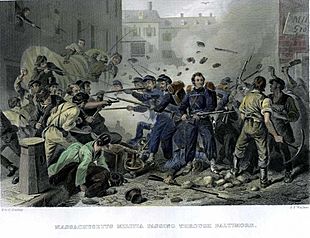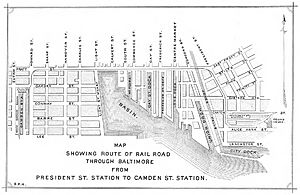Baltimore riot of 1861 facts for kids
Quick facts for kids Baltimore riot of 1861 |
|||||||
|---|---|---|---|---|---|---|---|
| Part of the American Civil War | |||||||
 "Massachusetts Militia Passing Through Baltimore", an 1861 engraving of the Baltimore Civil War riots |
|||||||
|
|||||||
| Belligerents | |||||||
|
|
|||||||
| Commanders and leaders | |||||||
| None | |||||||
| Casualties and losses | |||||||
| 5 (soldiers) killed, 36 wounded | 12 (civilians) killed, unknown hundreds wounded | ||||||
The Baltimore riot of 1861 was a violent clash in Baltimore, Maryland, on April 19, 1861. It happened between people who supported the Southern states (the Confederacy) and soldiers from Massachusetts and Pennsylvania. These soldiers were on their way to Washington, D.C. to help protect the capital at the start of the American Civil War. This event marked the first time Union soldiers were killed by hostile action during the war, even though the attackers were civilians. Some civilians also died in the fighting.
Contents
Why the Riot Happened
In 1861, many people in Baltimore did not want a war with the Southern states. Some strongly supported the Southern cause. Baltimore was known as a "pro-Southern city." In the 1860 election, Abraham Lincoln received very few votes there.
Lincoln's opponents were angry when he secretly traveled through Baltimore in February 1861. He was on his way to his inauguration as president. He feared a rumored plot to harm him. This secret trip made tensions in the city even higher.
Baltimore also had a large population of free African Americans. Many white people there supported the Union and wanted to end slavery. These different loyalties created a lot of tension in the city. People who supported the South formed groups called "National Volunteers." Those who supported the Union called themselves "Minute Men."
The Start of the Civil War
The Civil War officially began on April 12-13, 1861, when Confederate forces attacked Fort Sumter in South Carolina. After this, President Lincoln asked for 75,000 soldiers to help get back U.S. property in the South. This request made more Southern states decide to leave the Union.
Maryland was a "border state." This meant it was a slave state but had not seceded. Its loyalty was uncertain. Many Marylanders who supported the South wanted to join the Confederacy. Their anger grew when Lincoln asked for volunteers to end the rebellion.
New groups of soldiers from Northern states began moving south. Their main goal was to protect Washington, D.C., which was close to the Confederate state of Virginia. Baltimore's mayor, George William Brown, and police chief, George Proctor Kane, knew there might be trouble. They tried to keep the peace in the city.
First Clashes in Baltimore
On April 18, 1861, about 460 Pennsylvania soldiers arrived in Baltimore. They were joined by U.S. Army troops. These soldiers were mostly unarmed. Southern supporters gathered to confront them. The city police helped the soldiers pass safely through the city. However, people threw stones and bricks at them. One person traveling with the soldiers was hit. Despite this, the Pennsylvania troops made it to the U.S. Capitol.
The Riot on Pratt Street
On April 17, the 6th Massachusetts Militia left Boston. They arrived in New York City and then Philadelphia. On April 19, they headed to Baltimore. They knew their trip through the city might be difficult.
Baltimore had a rule against steam trains running through the city center. This meant there was no direct train track between the two main train stations. Train cars had to be pulled by horses along Pratt Street to connect the lines.
As the Massachusetts soldiers were moving between stations, a large crowd of anti-war people and Southern supporters attacked them. The crowd blocked the train cars. About 240 soldiers had to get out and march through the city.
The mob followed the soldiers, throwing things and blocking their path. They attacked the soldiers at the back of the group with "bricks, paving stones, and pistols." In response, some soldiers fired into the crowd. This started a big fight involving the soldiers, the mob, and the Baltimore police.
The soldiers eventually reached the Camden Street Station. The police managed to keep the crowd away from them. The soldiers left behind much of their equipment, including their band's instruments.
Casualties
Five soldiers were killed or badly wounded in the riot. About 36 soldiers were also hurt. At least 12 civilians died, and many more were injured. One of the soldiers, Luther C. Ladd, is often called the first Union soldier killed in action during the Civil War.
After the attack, the office of the Baltimore Wecker, a German-language newspaper, was destroyed by the same mob. The newspaper's staff had to leave town because their lives were threatened. The paper supported the Union cause.
Aftermath of the Riot
The Baltimore riot was a major event that pushed the North and South closer to full-scale war. It was the first time blood was shed in a conflict between the two sides. This made it very hard to find a peaceful solution.
After the riot, there were small fights in Baltimore for about a month. Mayor Brown and Maryland Governor Hicks asked President Lincoln not to send more troops through Maryland. They wanted to avoid more violence. However, Lincoln said that Union soldiers could not "fly over Maryland, nor burrow under it." This meant they had to pass through the state.
Governor Hicks also allowed the Maryland state militia to disable railroad bridges into the city. This was to stop more Union troops from coming. One militia leader, John Merryman, was arrested later. His arrest led to a famous legal case about whether the president could suspend certain rights during wartime.
Securing the Route to Washington
On April 19, Union General Benjamin Butler was ordered to open a safe route from Annapolis to Washington, D.C. His troops arrived in Annapolis on April 20. Even though the Governor and Mayor of Annapolis protested, Butler insisted his hungry troops needed to land.
The Union troops then moved towards Washington. On April 25, the 7th New York Infantry Regiment became the first troops to reach the capital using this new route.
Maryland's Decision
After the riot, some people wanted Maryland to leave the Union. Governor Hicks called a special meeting of the state legislature. He chose to meet in Frederick, a part of the state that supported the Union.
On April 29, the legislature voted against leaving the Union. The vote was 53 to 13. However, they also voted not to reopen rail links with the North. They asked Lincoln to remove the growing number of federal troops from Maryland. It seemed they wanted Maryland to stay neutral in the conflict.
Federal Control of Baltimore
Many more Union troops arrived in Maryland. On May 13, General Butler sent Union troops into Baltimore and declared martial law. This meant the military took control of the city.
President Lincoln later had the mayor, police chief, and city council of Baltimore arrested. They were held without charges. The Chief Justice of the Supreme Court, Roger B. Taney, said Lincoln's actions were against the Constitution. But Lincoln did not follow this ruling.
In September, a Baltimore newspaper editor, Frank Key Howard, criticized Lincoln's actions. He was also arrested and held in Fort McHenry. This was the same fort where his grandfather, Francis Scott Key, had written "The Star-Spangled Banner".
To keep Baltimore secure, the Union army built new forts around the city. These included Fort Worthington and Fort Marshall.
Maryland, My Maryland
The riot also inspired a song. James Ryder Randall, a teacher from Maryland, wrote "Maryland, My Maryland" for the Southern cause. He had lost a friend in the riots. The song mentioned the riot with lines like "Avenge the patriotic gore / That flecked the streets of Baltimore." This song later became Maryland's state song in 1939. However, it was removed as the state song in 2021.
On September 17, 1861, federal troops arrested 27 state lawmakers. This was done using Lincoln's power to suspend certain rights. As a result, the legislative meeting was canceled. A new legislature was elected later that year.



